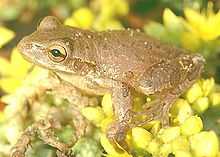Osteopilus
From Wikipedia, the free encyclopedia
| Osteopilus | |
|---|---|
 | |
| Osteopilus septentrionalis | |
| Scientific classification | |
| Kingdom: | Animalia |
| Phylum: | Chordata |
| Class: | Amphibia |
| Order: | Anura |
| Family: | Hylidae |
| Subfamily: | Hylinae |
| Genus: | Osteopilus Fitzinger, 1843 |
| Species | |
|
8 sp., see text | |
Osteopilus is a genus of frogs in the Hylidae family. These species have a bony co-ossification on the skull resulting in a casque, hence its name ‘bone-cap’, from osteo- (‘bone’) and the Greek pilos (πῖλος, ‘felt cap’).[1] Color varies between uniform brown, brown-gray, or olive with darker markings or marbled with greens, grays or brown, making a distinct pattern. The finger disks are round; the fingers with a reduced webbing; eyes and tympanum are large. Their natural range includes the Greater Antilles and the Bahamas, but O. septentrionalis has also been introduced to the Lesser Antilles, Hawaii and Florida (USA).
Species
Eight species are recognized in this genus:[2]
| Binomial name and author | Common name |
|---|---|
| O. crucialis (Harlan, 1826) | Jamaican snoring frog or Harlan's Antilles frog |
| O. dominicensis (Tschudi, 1838) | Hispaniolan common tree frog or Dominican tree frog |
| O. marianae (Dunn, 1926) | yellow bromeliad frog or Spaldings tree frog |
| O. ocellatus (Linnaeus, 1758) | Jamaican laughing frog, or Savanna-la-Mar tree frog, Brown tree frog |
| O. pulchrilineatus (Cope, 1870) | Hispaniolan yellow tree frog |
| O. septentrionalis (Duméril and Bibron, 1841) | Cuban tree frog |
| O. vastus (Cope, 1871) | Hispaniolan giant tree frog |
| O. wilderi (Dunn, 1925) | green bromeliad frog or Wilder's tree frog |
References
- ↑ Dodd, C. Kenneth (2013). Frogs of the United States and Canada 1. The Johns Hopkins University Press. p. 20. ISBN 978-1-4214-0633-6.
- ↑ Osteopilus, Amphibian Species of the World 5.6
External links
- AmphibiaWeb: Information on amphibian biology and conservation. [web application]. 2008. Berkeley, California: Osteopilus. AmphibiaWeb, available at http://amphibiaweb.org/. (Accessed: Apr 24, 2008).
- eol - Encyclopedia of Life taxon Osteopilus at http://www.eol.org.
- ITIS - Integrated Taxonomic Information System on-line database Taxon Osteopilus at http://www.itis.gov/index.html. (Accessed: Apr 24, 2008).
- GBIF - Global Biodiversity Information Facility Taxon Osteopilus at http://data.gbif.org/welcome.htm
This article is issued from Wikipedia. The text is available under the Creative Commons Attribution/Share Alike; additional terms may apply for the media files.